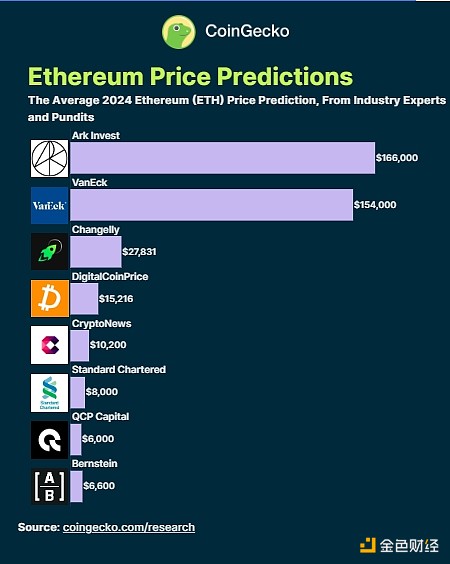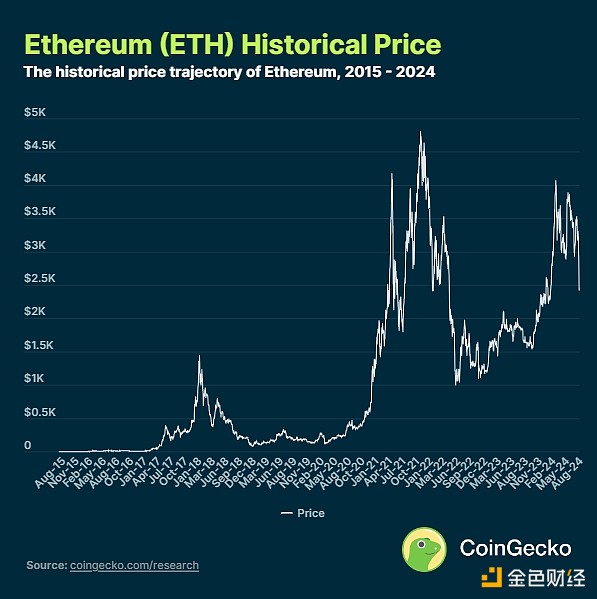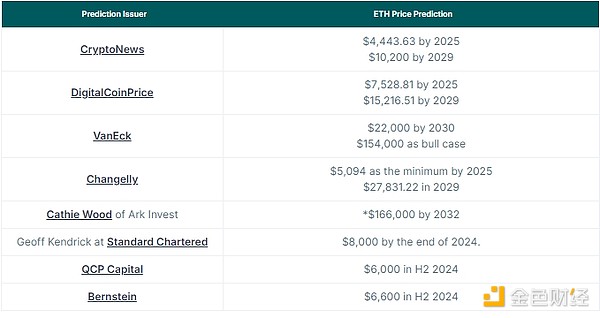Author: Shane Neagle, Coingecko; Translator: Deng Tong, Golden Finance
Ethereum's market capitalization is second only to Bitcoin, and over the past year, Ethereum has been on par with Bitcoin at major turning points. However, over the year, Ethereum has lagged behind Bitcoin, with the two rising 31.6% and 85.8%, respectively. The potential for an Ethereum ETF boosted the cryptocurrency, but its gains have been wiped out.
Despite the price crash of both cryptocurrencies in late July, hopes for an Ethereum ETF are high based on the widely successful launch of the Bitcoin ETF. Given these and other factors, what price range can ETH holders expect in the near and medium term?
What is the Ethereum price prediction for 2024?
The average Ethereum price forecast for the end of 2024 by top analysts, institutions, and fund managers is $6,404.

All eight forecasters are bullish on Ethereum and expect ETH to rise to between $4,400 and $166,000. The lowest target from CryptoNews is $4,443.63, while the highest from Ark Invest’s Cathie Wood is $166,000. While all experts expect prices to rise, only two predict ETH will reach six figures. VanEck predicts ETH will rise to $154,000 in a bullish scenario, while Cathie Wood expects it to rise to $166,000. However, most price predictions are based on longer time frames, with only Bernstein, QCP Capital, and Standard Chartered providing a time frame within a year. As a result, their predictions also tend to be on the lower end of the $6,000 to $8,000 range.
This year, the biggest driver of Bitcoin’s record high of $73,780 was the legitimization effect achieved through exchange-traded funds (ETFs). This investment vehicle opened up access to Bitcoin, but without the risks that come with self-custody. Now an Ethereum ETF is expected to have the same effect. However, a survey conducted by Grayscale between April 30 and May 2, 2024 showed a split in sentiment. While 25% of respondents believe that ETF approval will increase Ethereum capital inflows, 25% believe that it will not affect the investment thesis of Ethereum. The most important finding from the survey is that funds launching Ethereum ETFs will have a lot of marketing to do, as 43% of respondents are unfamiliar with the concept of an Ethereum ETF for spot trading.
Ethereum Price Prediction Analysis
As of August 6, ETH's price has plunged 15.5% over the past 30 days, hovering around $2,600. This is reminiscent of the plunge that occurred after the start of the Fed's rate hike cycle in April 2022. This time, federal funds futures predict three rate cuts by the end of 2024, with the first occurring in September with an 82.7% probability. Depending on the severity of the need for rate cuts to stimulate the economy, this could be a tailwind or a headwind.

If a hard landing leads to a deep market recession, this is unlikely to help ETH's capital inflows, as weakened discretionary spending will shorten the time for capital inflows. In addition, Mt. Gox repayments are expected to bring Bitcoin selling pressure, which may put further pressure on ETH. Moreover, Just days after the ETH ETF was approved, it was clear that “sell the news” pressure was brewing as the price of ETH dropped by more than 10%.
On the bright side, Ethereum is not only firmly behind Bitcoin, but also has higher growth potential.According to VanEck’s analysis, its reliance on layer 2 networks, coupled with sharding, makes it a prime candidate to absorb all traffic from multiple use case scenarios. On the regulatory front, efforts are underway to make ETH more decentralized. Lido, which took the first place with a 29% staked share, launched the Community Staking Module (CSM) to ease centralization concerns and shed its “security” moniker.
Overall, analysts and experts agree that ETH’s price is trending upwards in the long term, well above the current price level of around $2,600.
Potential drivers of Ethereum’s price
Ethereum’s profitability has both weakened and strengthened following its transition from Proof of Work (PoW) to Proof of Stake (PoS) in September 2022. On the one hand, becoming a validator requires staking ETH, which reduces the network’s potential to maintain decentralization.
Similarly, PoS networks are more likely to censor transactions because the user’s trust is delegated to the network’s validators. This is in stark contrast to trustless PoW networks such as the Bitcoin mainnet. In addition, Ethereum is an ongoing coding project with a complex roadmap that has the potential to bring unforeseen changes. Therefore, it is more difficult to “sell” Ethereum to potential investors because it carries a higher risk. In contrast, Bitcoin is an extremely conservative digital commodity focused on absolute scarcity and network security, making it more attractive to investors looking to hedge against currency depreciation.
On the other hand, Ethereum’s PoS brings blockchain scaling to reality as a network of layer 2 networks. On average, the Ethereum network facilitates twice as many daily transactions as Bitcoin. Meanwhile, Ethereum’s average transaction fee has steadily declined. With the Ethereum 2.0 roadmap implementing sharding and achieving 100,000 transactions per second (TPS) versus Bitcoin’s 7 TPS, a clear picture emerges:
With ~13.9% of the total crypto market share, Ethereum is a proxy for dozens of layer 2 networks and their respective cryptocurrencies, simplifying Ethereum’s appeal as prime smart contract real estate to blockchain investors.
Ethereum is neither inflationary nor deflationary, its status is determined by network activity. The EIP-1559 token burn mechanism generally leads to inflationary periods when network activity decreases, and exerts deflationary pressure when network demand increases.
Investing in Ethereum is akin to owning early Visa/Mastercard shares, but for a global decentralized financial network.
In other words, without ETH’s capped maximum supply, and with the drawbacks derived from PoS, Ethereum may struggle to attract the massive influx of capital that has flowed into Bitcoin. However, the potential for a deep ecosystem of decentralized applications (dApps) hosted by the Ethereum network may offset these factors, or even outweigh them.
Ethereum Price Prediction
The top eight ETH price predictions are as follows:
 All predictions are made in 2024, and the averages are for reference only. *Without Cathie Wood's outlier, the average Ethereum price prediction would be $6,404 by the end of 2024 or early 2025.
All predictions are made in 2024, and the averages are for reference only. *Without Cathie Wood's outlier, the average Ethereum price prediction would be $6,404 by the end of 2024 or early 2025.
 Alex
Alex
 Alex
Alex Jasper
Jasper Catherine
Catherine Catherine
Catherine Bitcoinist
Bitcoinist Bitcoinist
Bitcoinist Bitcoinist
Bitcoinist Cointelegraph
Cointelegraph Ftftx
Ftftx Cointelegraph
Cointelegraph